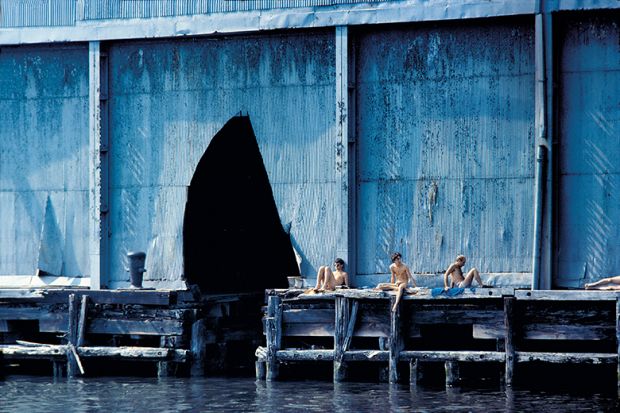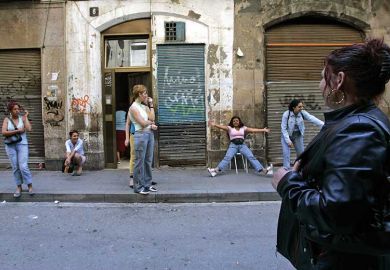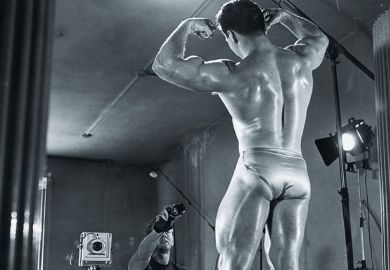The 1970s are a difficult period in gay history, bordered by the advent of Aids in the early 1980s – the decade as “lost paradise (or hell) of sexual experimentation”, as Jonathan Weinberg puts it. Pier Groups attempts to banish Aids from its time frame (1971 to 1983), but given our retrospective knowledge that many of those discussed will succumb to the deadly virus, that proves impossible.
New York’s piers, along the Hudson River, were the sites both of casual sex and open-air, mass-bodied, male sunbathing. Men moved between the dark sheds of the decaying structures and their sunlit decks. There are pictures of both in Pier Groups. The book’s cover has Shelley Seccombe’s 1977 image of the bright exterior of Pier 52, with its sunbathers next to a black, shark-fin-shaped laceration in its wall, indicating the possible dark pleasures and dangers within. Appropriately, the piece is called Sunbathing on the Edge: men, nearly always young and beautiful, proclaimed their sexual freedom in broad daylight – as in Stanley Stellar’s photograph from the same year of a male couple engaged in naked, open oral sex.
However, the piers were also the habitat of a variety of artists and photographers, peers at the piers as Weinberg says somewhere, who used these sites as performance sites, studios and as spaces for graffiti, murals and photography. The gash in Pier 52 was actually the work of the avant-garde artist Gordon Matta-Clark, whose chainsaw and acetylene-torch building cuts, “anarchitecture”, opened up the roof and walls of the building, letting the sunlight into the vast expanse in a work called Day’s End (1975). Ironically, many of those who photographed Pier 52 were unaware of the significance of Day’s End, but its man-made gashes are there on the book’s cover, in Alvin Baltrop’s photographs of men cruising, and in Frank Hallam’s image of the demolition of the pier in 1979, where all that remains is one of the wounded walls.
Weinberg has fresh perspectives on luminaries such as David Wojnarowicz. However, one of the joys of Pier Groups is its inclusion of the work of lesser-known artists. The amateur photographers Hallam and Leonard Fink appear alongside the better-known Baltrop, Seccombe, Stellar and Arthur Tress. Another of its pleasures is Weinberg’s delight in synchronicity, a product, of course, of his lovingly intricate research. When Stellar was photographing the male porn star J. D. Slater on Pier 46, he ran into the famous photographer Peter Hujar. The latter asked Stellar to photograph him having oral sex in the background, while the porn star posed next to graffiti by the even more famous artist Keith Haring. The result was Peter Gets His Dick Sucked (1981).
The new Whitney Museum of American Art, as Weinberg observes, now looks out over the space where Pier 52 once stood, amid an expanse of gentrification and high fashion stores. All that is left of Pier 54 is the steel arch that once stood at its entrance, now a skeletal piece of public art. Pier Groups is a compelling memorial to a lost world.
Barry Reay is Keith Sinclair professor of history at the University of Auckland and the author, most recently, of Sex in the Archives: Writing the Histories of American Sex (2018).
Pier Groups: Art and Sex along the New York Waterfront
By Jonathan Weinberg
Penn State University Press
232pp, £27.95
ISBN 9780271082172
Published 7 June 2019
POSTSCRIPT:
Print headline: Ports of call for the men of NYC
Register to continue
Why register?
- Registration is free and only takes a moment
- Once registered, you can read 3 articles a month
- Sign up for our newsletter
Subscribe
Or subscribe for unlimited access to:
- Unlimited access to news, views, insights & reviews
- Digital editions
- Digital access to THE’s university and college rankings analysis
Already registered or a current subscriber?








